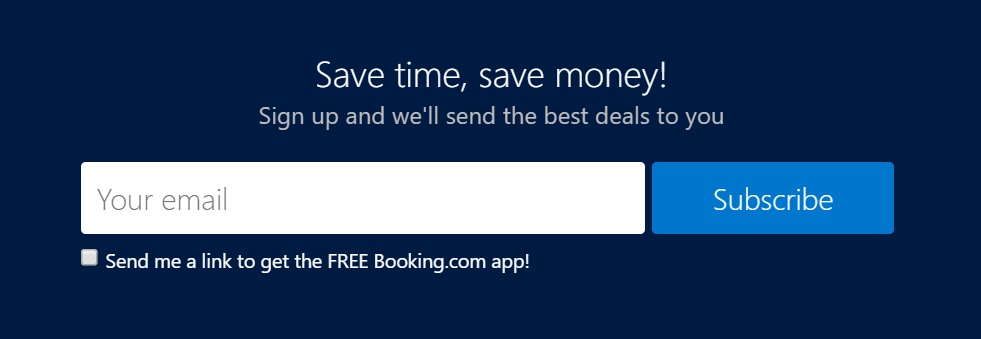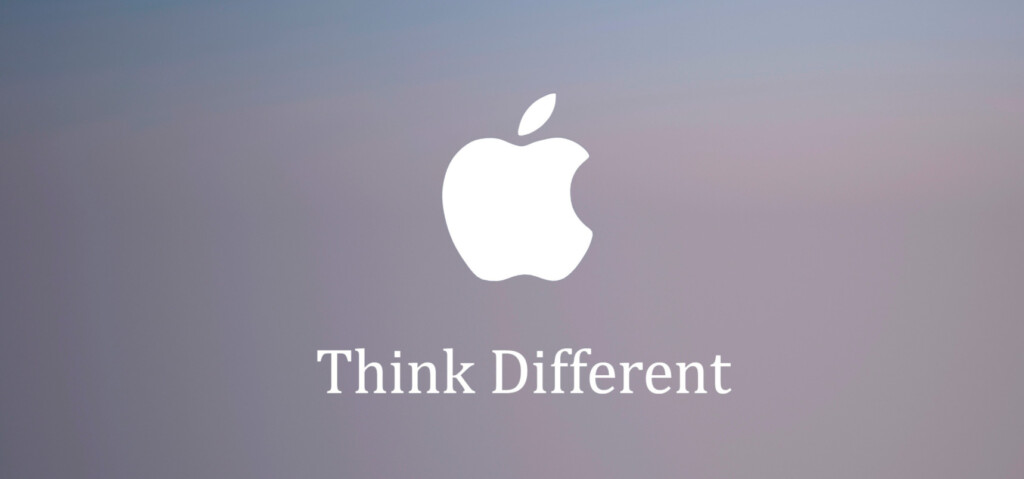What Is a Tagline
What is a blog tagline? Formally, it is a short phrase that presents the blog topic. Taglines should be informative for readers rather than just extraordinary or too cutesy. To create one, focus on your message, brand, type of audience and some other important factors we’ll mention below.
A tagline is usually placed on the header of the website next to the logo. Most often, bloggers put it in the top left corner of the blog. But there are many other options: longer taglines can be placed in the footer or tied with a relevant image (in case of a specific product), as to not occupy too much space on the header. For example, Booking.com’s tagline is placed just above the subscription form, at the bottom of the page:

Why Do You Need a Tagline
Domains are the first thing about the websites that we usually see in the search results, but what should you do when the popular domain names have already been grabbed? Create a catchy tagline and place it next to the blog name.
The main purpose of a tagline is to inform users about the blog’s topic and content. Naturally, domains attract users’ attention, but taglines keep it and incentivize readers to dive deeper into the content.
Great Tagline Examples
Analyzing taglines can bring you inspiration and enthusiasm. One of the brightest examples is Apple’s tagline, “Think different.” It doesn’t describe the brand’s niche but makes people feel special and creative.

Nike’s tagline “Just Do It” has a motivational purpose as well, inspiring people to be active. It’s a great example of a call-to-action tagline. By the way, it helped Nike increase sales from $877M up to $9.2B in just one year.
Speaking of travel niche, let’s take an example of Dan Flying Solo. Its tagline “Getting lost in places/meeting new faces” charms with a rhythm and perfectly describes the blog’s goal.
Lili’s Travel Plans encourages viewers to “Explore with emotion, live for the journey.” This tagline wakes our sense of adventure and promises breathtaking experiences.
How to Make a Tagline
How to come up with a tagline? Let’s start with the step you shouldn’t take: don’t copy famous brands’ taglines since you haven’t achieved their success yet. From the very beginning, a tagline is an investment in your own brand’s growth. It will help people recognize you among plenty of your competitors. The following tips will provide you with knowledge on how to create your personal tagline.
Consider Your Mission
Whether your blog’s goal is to inspire or educate users, recommend or sell goods, say it openly. A tagline might express your company’s mission or present key offers for the customers.
Sometimes, it will be enough to simply catch readers’ attention. One of the world’s most famous advertisements for piano lessons had the following headline: “They laughed when I sat down at the piano. But when I started to play!-” An unfinished sentence is intriguing, and most people can’t get past it. So why not use this method when creating your tagline?
Travel blog Maptia features the tagline: “Home to a world of stories.” It reflects the website’s purpose to help people experience wonders around the globe through storytelling.
Consider Your Offer
A good idea might be to mention how your offer is different from others. You don’t have to say that you are better than competitors, just show uniqueness. For example, Legal Nomads‘ tagline “Telling stories through food” immediately identifies the niche and singles out the blog from thousands of competitors.
Nomadic Matt’s tagline “Travel smarter, cheaper, longer” attracts followers looking for ways to save money and enjoy long holidays.
Consider Your Audience
Blog tagline formats should be relevant to your audience. Try to take into consideration their age, interests and even geolocation. If you target a local community, why not insert the name of the city into a tagline? For international websites, it’s better to use such words as “world,” “globe,” “everyone,” etc. For example, Planet D’s slogan “Adventure is for everyone” targets globally.
Consider Your Personality and Brand
The best blog taglines always reflect the author’s personality. People subscribe to websites when they like the angle of materials and therefore their writer. For example, Angie Away’s tagline is “Live the global life with the girl next door.” It makes the blog more credible and appeals to people who like to see life through the eyes of another person, but don’t strive for anything extraordinary.
BBQ Boy shows that the blog has entertaining content with a tagline “The travels of BBQ boy and Spanky.” A funny nickname makes people smile and attracts those who look for fun.
Adjectives are very useful when describing your brand’s advantages. For example, Global Jet Airlines’ slogan “Light is faster, but we are safer” builds an image of a credible company, which is crucial for airlines.
How to Put It Into Words
How to write a blog tagline? A great tagline would be short and powerful, clearly stating your company’s goal. Here are some tips for creating an effective tagline:
- Use verbs, especially imperative mood that perfectly motivates and encourages users.
- Try to avoid passive voice in order to personalize your taglines and make them sound alive.
- Use power vocabulary to trigger a psychological or emotional response.
- Make taglines clear, rhythmic and memorable.
- Use personal pronouns such as I, You, We and Your to become closer to your audience.
When playing with the words, note that Google only displays up to 70 symbols of a title meta tag. Check whether your tagline is suitable for the 512-pixel screen before you’ll endorse it. You can use a tagline generator for blogs (such as Slogan Generator, Free Slogan Maker, etc.), but only as a foundation or a benchmark.
How to Bait People With Your Tagline
A good tagline is indispensable for blog success. The website’s name and design catch the attention, but a tagline makes visitors stay by expressing the company’s mission and offer or appealing to a particular audience. Make your slogan bright, meaningful, clear and catchy.
Use the good tagline examples and the tips above for inspiration, so that building a straight-to-the-point tagline will be a piece of cake.

